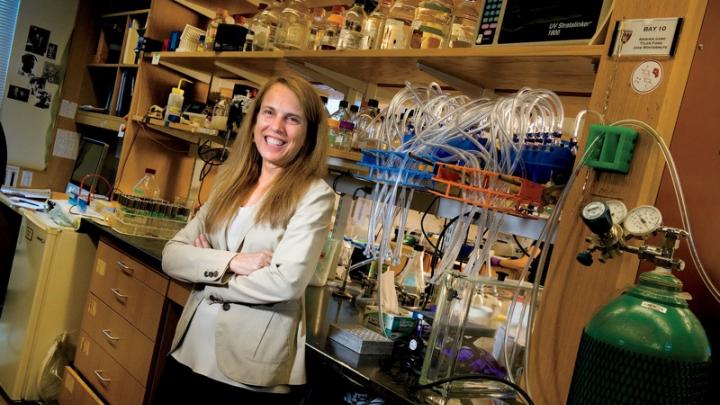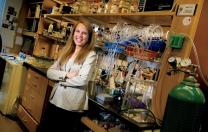Biology will be the technology of this young century. During the past 50 years, biology has developed from a soft science that described macroscopic phenomena into a reductionistic discipline that aims to explain life in terms of chemistry and physics. The emergence of molecular biology in the 1950s and recombinant DNA technology in the 1970s have led to an outpouring of information about how life works. The net result is that biology is where chemistry was 30 years ago—sufficiently understood that many basic processes are known in some detail, and with vast potential to create wide-ranging benefits for humanity.
Harvard has been central in this evolution. When I arrived as a postdoc, the recombinant DNA era was in full swing. Many early applications of molecular biology were initiated here and the first generation of biotechnology companies, including several Harvard spin-offs, had just formed. Recombinant DNA was revolutionizing our understanding of basic biochemical and cell biological processes. During those years, the way we study fundamental biological processes underwent a major shift that has now culminated in sequenced human genomes, knowledge of many cellular processes, and a clear path to unraveling roles for individual molecules.
Of course, many details of molecular-biological processes remain to be worked out—these will be important in understanding growth and development, pathogenesis, disease, and many other aspects of basic and applied biology. But adding more details is not likely to change the way we think about biology. Indeed, the mass of detail already available is so overwhelming that one might feel much of the mystery of life is gone.
What we are left with are the mysteries that cannot be answered with detail alone. Several years ago, I was fortunate to be involved in the founding of the new department of systems biology at Harvard Medical School and the systems biology graduate program. Harvard was, again, ahead of the curve in founding these programs, which are aimed at the next level of understanding in biology. This new discipline seeks to create a picture of biological function and behavior that spans the size scale from atomic to macroscopic. What are the key events at the molecular level that drive change at the evolutionary and ecological levels? How do genetic differences between individuals combine to determine responses to environment and sensitivity to disease? A major focus of the field is quantitative measurement of the dynamic behavior of individual components of the system, and modeling to integrate the behavior of many components to explain system behavior.
An important area of application is drug development. The great drive of molecular biology and genomics has been to identify what goes wrong in disease: what are the molecular differences between a sick organism and a healthy one? Increasingly, we realize that for many diseases there is no simple answer. Even when a single mutation is dominant in predisposing an organism to disease, it is often far from clear how to use this information to create a cure. We envision a new approach to pharmacology that, instead of considering individual targets, asks how a drug or combination of drugs affects entire pathways. The goal is to help increase the predictability of drug efficacy and drug toxicity, and our ability to identify which subsets of patients would benefit from the drug. Our current ability to predict the action of a given drug is so poor that even a small step forward would be a large contribution to reducing human suffering from disease.
Following naturally from the ability to predict the behavior of biological systems is the ability to design new biological systems. Synthetic biology, an even newer discipline that grows naturally from systems biology, seeks to engineer whole organisms to perform useful tasks. Considered as technology, biological systems are extraordinarily powerful: they can use air and water to produce building materials, perform chemical syntheses that are the envy of human chemists, and precisely pattern atoms to form nanoscale structures. Can we use this technology to solve real-world problems? To do this, we need to be able to engineer complex new biological systems and know how they are going to behave. This can be done only with a heavy dose of math—quantitation and computation—and hence needs to draw on many of the tools of systems biology. We imagine a time when the engineering of a biological system is analogous to that of designing a computer chip. We are a long way from this goal, but one must start somewhere.
With biological carbon as the “silicon” of this century, the possibilities are infinite. Take energy, for example. Solar energy is our greatest natural resource and we currently use only a fraction of it. Increasing the efficiency of photosynthesis—a revolution in “green manufacturing”—might offer a biological solution to many of the current problems facing Earth and our dependency on fossil fuels. DARPA (the Defense Advanced Research Projects Agency), the supporter of the development of the Internet, has declared the rapid engineering of biology one of the highest national priorities, but achieving that goal will require a different mind-set as we move from a discovery-based to an application-based biology.
But there are still many large unanswered questions awaiting basic biological researchers. I see a major area of growth in the integration of biology with psychology, sociology, and economics. One of the most exciting challenges involves the question of how the brain works and where consciousness comes from. Molecular biology was pioneered by physicists at a time when biology was truly a distinct discipline. Today, there are no clear dividing lines among physics, chemistry, and biology, and there is general agreement about how the physical world works. There is no similar agreement about how our minds work: the economist assumes that rational behavior is dominant, for example, while a psychologist questions what fraction of human behavior is rational, and a biologist may ask whether rationality is even a useful concept, or merely an evolved illusion. How our genetic make-up, our past experiences, and our environments affect our group behaviors remains one of the major mysteries. We are now poised to tackle these problems, and many more. This century will be an exciting time to be a biologist!
Pamela A. Silver is professor of systems biology at Harvard Medical School and the Daniels Fellow at the Radcliffe Institute for Advanced Study.








